Dragonflies are stunning insects that can be seen in a range of vibrant colors and there are more than 7,000 species of them in the world today. Although there is often a common misconception that they live for only twenty-four hours, dragonflies can survive for one to eight weeks as adults. Dragonflies are large insects and although many now-extinct species that date back to prehistoric times were much bigger, there are still some pretty big ones around now. Take a look at this preview:
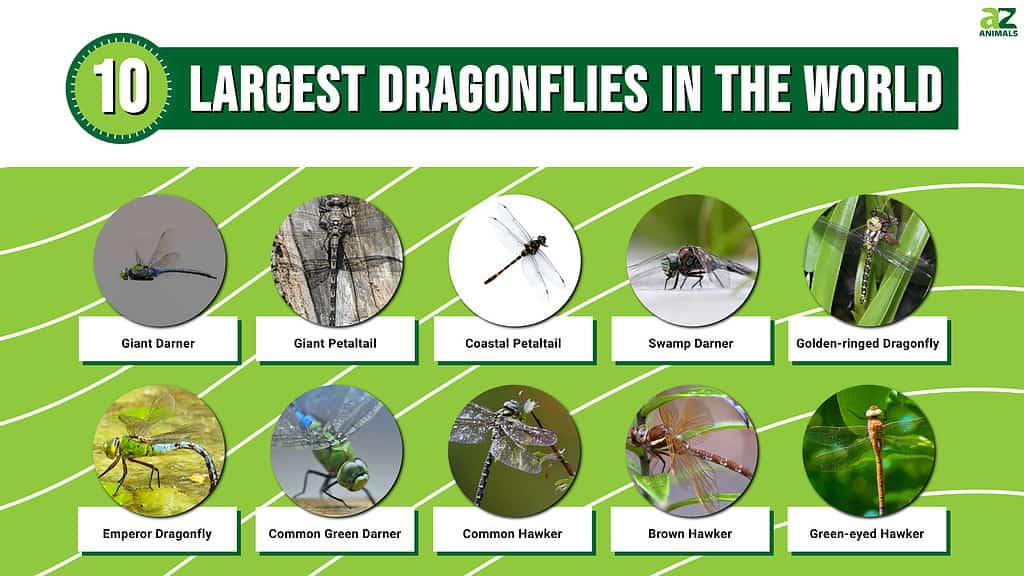
Read on to learn more interesting information about these large dragonflies. We have listed them listed by length, starting with the smallest of the group.
#10: Green-Eyed Hawker

©iStock.com/Sander Meertins
The green-eyed hawker reaches a length of 2.83 inches and is found across Europe, the Mediterranean, and North Africa. Although the green-eyed hawker is not under any threat, it is considered a rare and protected species in the UK, where it is known locally as the Norfolk hawker. These hawkers have a brown body with a yellow triangular mark on their abdomen and, as the name suggests, they have green eyes. Green-eyed hawkers prefer to live in marshlands and near ponds, which is where they lay their eggs. The males often fly around ponds to defend their territory, or hover over the center of the pond is small.
#9: Brown Hawker
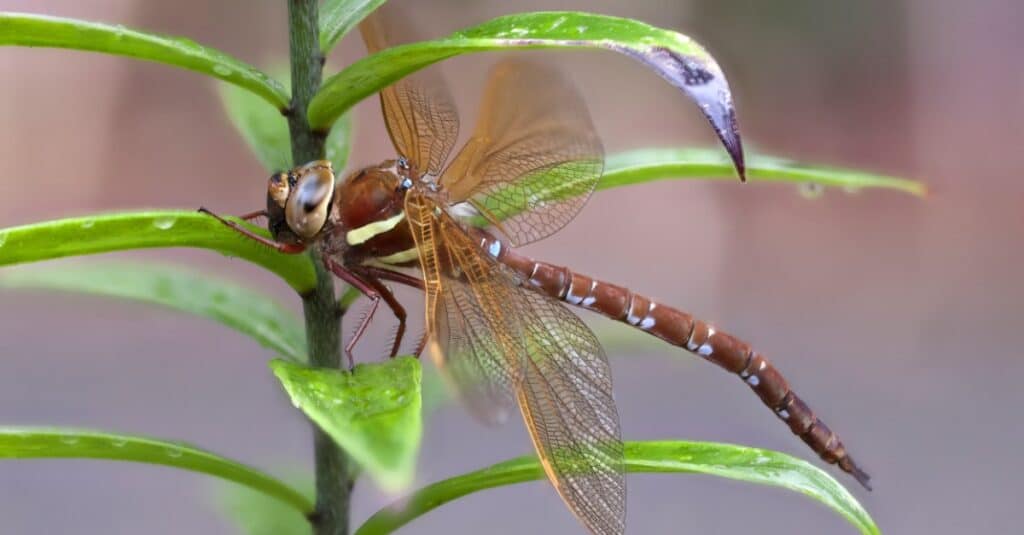
©Joe Kirby Photography/Shutterstock.com
Brown hawkers are found throughout Europe, but are particularly widespread across the UK. They are easily recognized by their appearance as they have a brown body with bronze wings, although the females have a few yellow markings on their abdomen and males blue and yellow markings. Brown hawkers reach lengths of around 2.9 inches and are found in woodland areas, although they breed in areas of water that are either still or slow-flowing. These dragonflies are extremely territorial and fiercely defend their territory against any intruders, often by flying backwards and forwards.
#8: Common Hawker
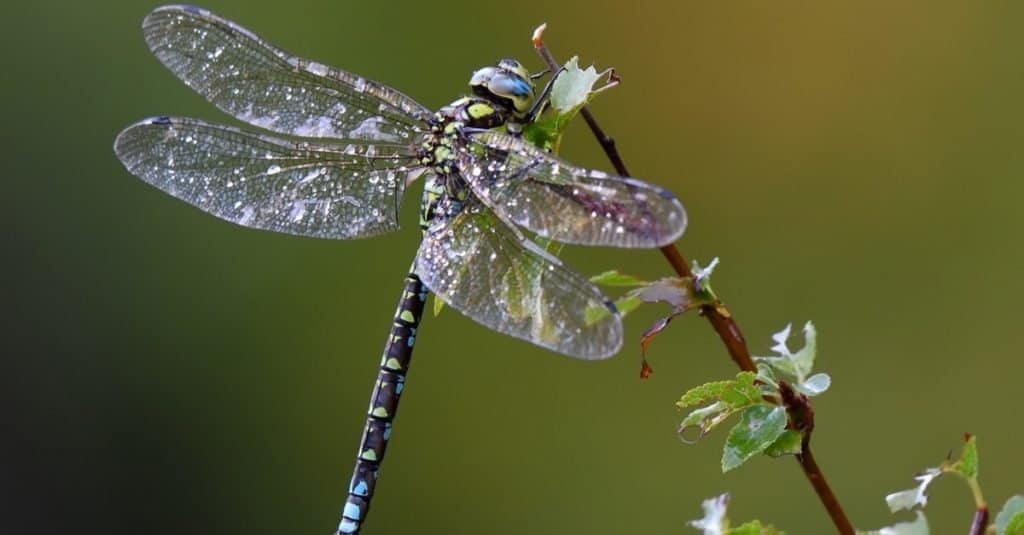
A stunning common hawker dragonfly
©aaltair/Shutterstock.com
The common hawker is widespread across most of Europe and North America and can reach a length of 2.9 inches. Also known as the moorland dragonfly, they are usually found on moors and woodland areas near small pools of water. Common hawkers have a stunning appearance with blue spots on their abdomen, although males have a black base color, while females are brown with blue or sometimes yellow spots. Female common hawkers sometimes try to avoid mating by diving out of the sky and pretending to die when they see a male.
#7: Common Green Darner

The common green darner is the official
insect
of Washington DC
©Photoongraphy/Shutterstock.com
As the official insect of Washington DC, the common green darner is widespread across North America but is also found in the Caribbean, Panama, Tahiti, China, and Japan. Reaching lengths of 3 inches and with a wingspan of 3.1 inches, the common green darner is easily identified by its large size and bright green appearance. They are usually found around ponds and lakes where the females lay their eggs in the vegetation surrounding the water. Common green darners feed on live prey all the way through their life cycle, with the aquatic nymphs (the stage between egg and adult dragonfly) eating tadpoles and small fish, and adult dragonflies eating a range of insects, such as butterflies, bees, and smaller dragonflies.
#6 Emperor Dragonfly
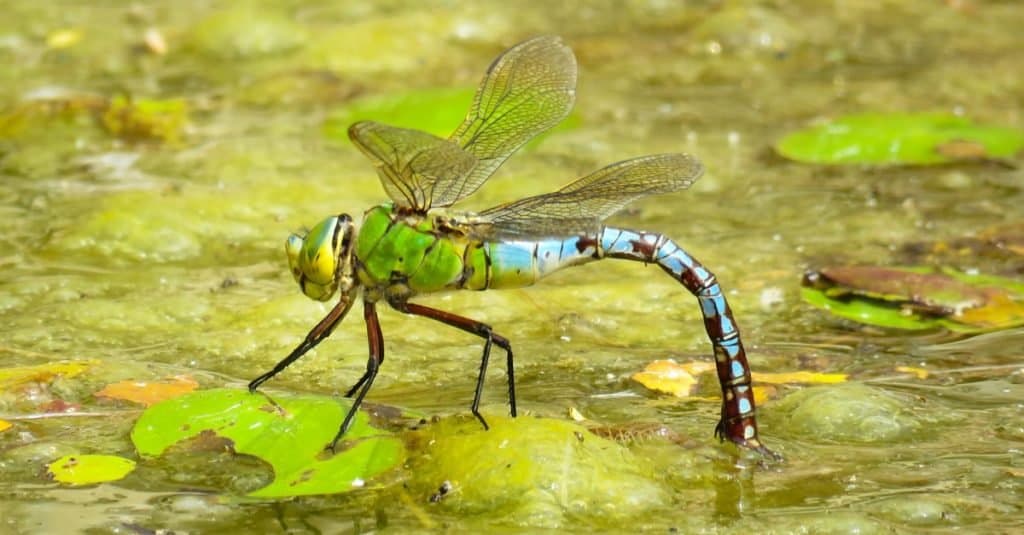
An Emperor dragonfly on water
©Helen Cradduck/Shutterstock.com
The emperor dragonfly, also known as the blue emperor, is found around ponds, lakes, and slow-moving rivers across Europe, Africa, and parts of Asia. With lengths of around 3.1 inches, emperors are easily identified by their size, color and abdomen that appears to droop when they are flying. Males have a brilliant blue abdomen and a green head while females are mainly green and both have a dark stripe down their backs. Emperor dragonflies are known for rarely being still and often even eat their prey while they are flying, including butterflies and other dragonflies.
#5 Golden-Ringed Dragonfly

Male (Aeshna cyanea)
©Velela – Public Domain
Found predominantly in the UK and reaching a length of 3.3 inches, the golden-ringed dragonfly is the biggest in the British Isles. With a stunning black and yellow appearance, it is easy to see where these dragonflies get their name from as their yellow markings do indeed look like gold rings. Preferring to live near rivers and streams, the much larger female lays her eggs in shallow water where the larvae blend in with the silt on the bottom. Golden-ringed dragonflies are capable of flying at great heights and feed mainly on small insects such as flies and midges, but also sometimes butterflies and bees.
#4 Swamp Darner
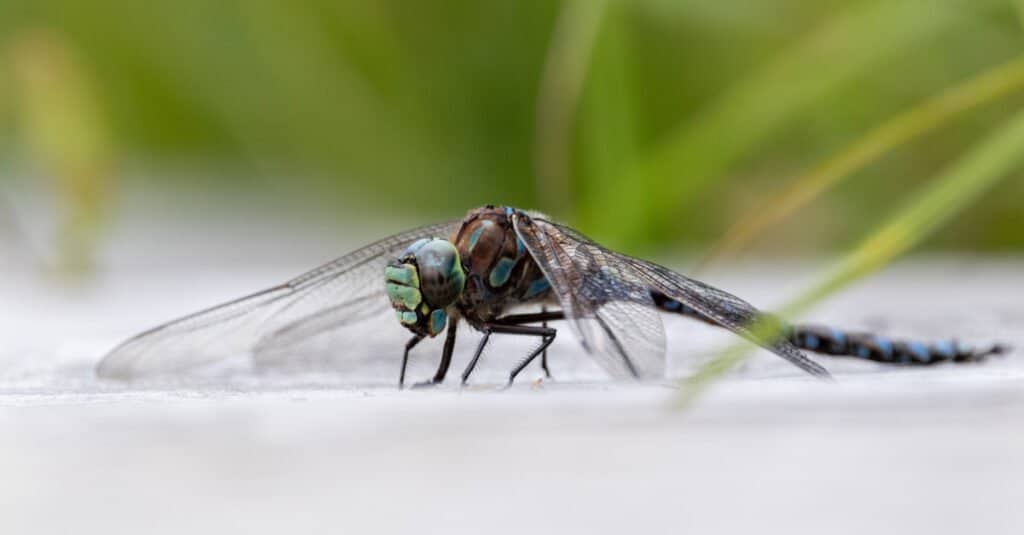
A swamp darner
©IHX/Shutterstock.com
The swamp darner is widespread across North America, and as the name suggests, it is often found around swamps, and occasionally woodland ponds. At first glance, they often appear to be dark brown, but they actually have a number of thin, lime-green rings on their abdomen. With a length of 3.5 inches, they are known to be quite a heavy dragonfly that only flies quite slowly. The females lay their eggs on wood or leaves near shallow water and when they hatch the nymphs then crawl into the water. Swamp darners feed on a range of insects and smaller dragonflies and often catch their prey as they are flying.
#3 Coastal Petaltail
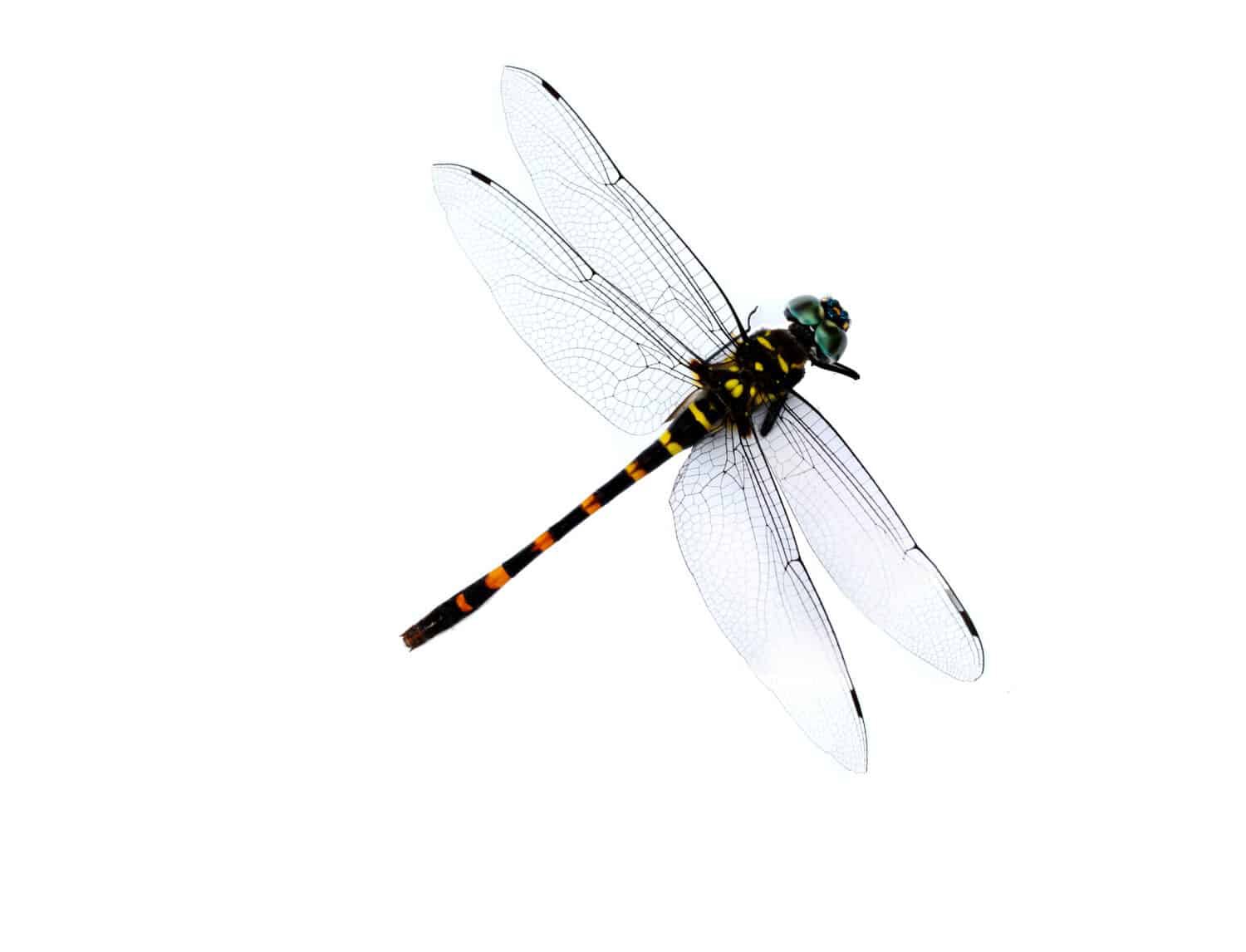
The coastal petaltail lives in thick vegetation surrounding swampland in Australia.
©supawadee promkot/Shutterstock.com
The coastal petaltail (petalura litorea) is an endangered species of dragonfly from Australia where it prefers to live in the thick vegetation surrounding swampland. Reaching lengths of around 4 inches, they have a distinctive appearance that makes them easily identifiable. Coastal petaltails have black heads with yellow spots while their bodies have black and yellow stripes and males have orange “petaltails” at the end of their bodies to attract females. These are particularly unusual dragonflies as, unlike most other species, they lay their eggs in burrows which are usually next to a body of water. Often, their larvae is at risk from predators, which is one of the reasons that their population is decreasing.
#2 Giant Petaltail
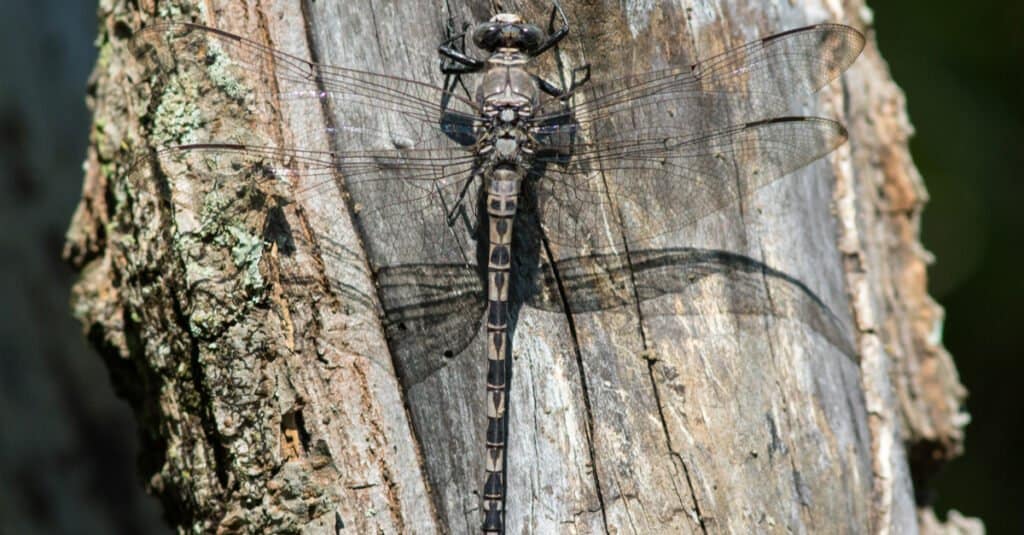
A grey petaltail on a tree
©Frode Jacobsen/Shutterstock.com
Coming a close second with a length of 4.92 inches is the giant petaltail (petalura ingentissima) which is found in Queensland, Australia. With a black body and yellow markings, they are quite similar in appearance to the coastal petaltail, although males have a black petaltail instead of an orange one. Giant petaltails also favor wet and boggy areas such as swamps and their larvae are commonly called “pit dwellers” because they live in burrows and usually feed on any passing prey that they can catch.
#1 Giant Darner

The giant darner can reach 5 inches in length
©yhelfman/Shutterstock.com
The giant darner (anax walsinghami) is the largest dragonfly in the world with a length of 5 inches and a wingspan the same. They are easily identifiable by the large blue spots on their bodies, green head, and clear wings. Although at first glance they can appear similar to the common green darner, they have a much larger abdomen which often appears to curve upwards. They are usually found near ponds, streams, and marshland in southwest America and even as far as Mexico. Giant darners are extremely useful as they eat a wide range of insects that are classed as pests, such as mosquitoes. Females lay their eggs in shallow water, and when they hatch, the nymphs eat small fish and tadpoles. There is a healthy population of giant darners and they are classed as a species of least concern.
Summary Of The 10 Largest Dragonflies In The World:
| Rank | Dragonfly | Size in Length | Location |
|---|---|---|---|
| 10 | Green-Eyed Hawker | 2.83 inches | Europe, the Mediterranean, and North Africa |
| 9 | Brown Hawker | 2.9 inches | Europe and the United Kingdom |
| 8 | Common Hawker | 2.9 inches | Europe and North America |
| 7 | Common Green Darner | 3 inches | North America, the Caribbean, Panama, Tahiti, China, and Japan |
| 6 | Emperor Dragonfly | 3.1 inches | Europe, Africa, and parts of Asia |
| 5 | Golden-Ringed Dragonfly | 3.3 inches | The United Kingdom |
| 4 | Swamp Darner | 3.5 inches | North America |
| 3 | Coastal Petaltail | 4 inches | Australia |
| 2 | Giant Petaltail | 4.92 inches | Australia |
| 1 | Giant Darner | 5 inches | Southwest United States and Mexico |
The photo featured at the top of this post is © yanikap/Shutterstock.com
Thank you for reading! Have some feedback for us? Contact the AZ Animals editorial team.






